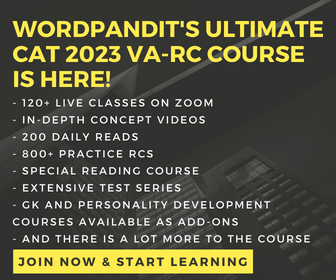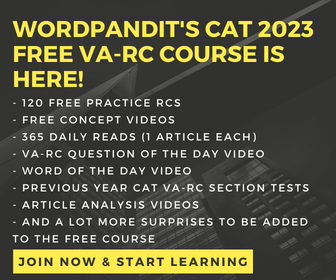CAT RC Question types: Strategies to tackle individual question types
In this article, I explore how to deal with Reading Comprehensions!
It has generally been seen that reading comprehensions can take up a lot of your energy and considering the fact you have to solve them in the first hour of the exam, it makes sense that all tips related to reading comprehensions are explored here.
As a recap of advice I have often passed in this section, there are two things that you need to do from today till the day of your exam:
- Solve at least 2 to 3 reading comprehensions a day.
- Make sure you read for 30 to 45 minutes; read diversely and from a variety of sources.
Now with the basic advice out of the pay, let us explore the things you need to keep in mind for different RC question types. Let’s explore these question types one at a time:
1. Main Idea Questions:
This question can use the following phrases: main idea, main point, central idea, central point, gist, summary and so on.
Make sure you identify the subject of the paragraph. On some occasions, this question features a simple trick. The main point of the passage will be vaguely retained but the subject will be changed. Some of the options would be too general or too specific in their focus and choice of subject, thereby introducing an error in these options. This is labelled as the SCOPE TRAP and you need to be extremely careful of this. Remember, always remain within the scope of the given passage and retain the main subject of the passage in the answer options.
2. Title Questions
The trick in identifying the right title is to identify the main idea of the passage and then co-relate with the answer options. The answer option closest to the main idea of the passage is the correct answer. In general, title questions feature answer options that are short and indirect. You need to understand the meanings of the answer options in order to identify the correct title.
3. Tone and Attitude Questions
Tone and attitude questions depend upon identifying the underlying sentiment of the author of the passage. These questions are all about identifying the nature of the passage. Each passage has three possible natures:
a. positive: something or someone is being described in a positive way.
b.neutral: something or someone is being described in a neutral way.
c. negative: something or someone is being described in a negative way.
Once you have identified the nature of the passage, you can co-relate it with the answer options and this will help you to identify the correct answer. Also, make sure you go through the list of common words used for building tone questions. This list will help you understand answer options better.
4. Inference Questions
These are the tricky ones. There are two types of inference questions that appear in CAT:
Genuine Inference based questions: In these questions, the inference is in-fact something which is unstated and is derived from the context provided.
Fact re-statement: A number of questions in this area are based on simply restating the facts in the passage. All that is done is that the given fact is restated in different words.
You need to be on the lookout in these questions and identify which type of a question it is. Also, try to identify the inference source in the passage and make sure you focus on the relative context (two lines above and below the given context). These generally contain a clue for the given answer.
Also, the key skill for deriving the correct inference is to understand the context and key ideas in the passage. Once you do this, you should be able to identify the correct answer.
5. Which of the following options is the author likely to agree/disagree with?
This is another tricky question type that has been making frequent appearances in the CAT exam. What do you consider in this question? In order to identify the agreements or disagreements of the author of the passage, you need to identify the key ideas in the passage. How do you do this? While reading the passage, you should always make a mental note of the key points or even scribble them in short hand while you are reading the passage. These will become crucial clues for you while solving the question.
Remember, the answer choices in this question type might feature options:
1. that closely resemble the facts or information given in the passage but contain some distortion. These are the hard ones to track.
2. over-generalize the given situation and thereby become irrelevant in the given context.
6. What would you like to ask the author of the passage?
This is a question type that CAT popularized last year. How do you answer this question type? Keep in mind that you need to ask questions that are relevant to the given context and shed light on something that the author has mentioned but not explained fully or convincingly. The most important thing that you need to keep in mind for this question type is that this question type is not about repeating what has already been given or answered in the passage. Avoid repetition at all costs and make sure the question you select lends some clarity of thought for the views presented by the author of the passage.
Hopefully you have learnt something of value in this article. I have covered the prominent question types in this article. In case you want help with some other question types, you can always leave a comment for me and I will address the query for you.


















